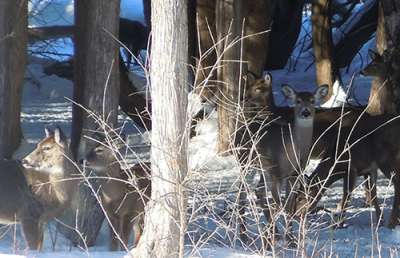In northern states, where deep snowpack causes deer to spend much of the winter under the dense canopy of evergreen stands, the animals’ nitrogen-rich waste may be making the soil less favorable for growing the very trees that protect them. A team of researchers at Michigan Technological University has found that increased nitrogen due to heavy winter use is hastening the transition of forests from eastern hemlock to hardwood species.
According to forestry professor Christopher Webster, deer seek out stands of hemlock, white cedar, balsam fir, and other evergreens during cold northern winters as a refuge from deep snow, wind, and predators. These deeryards can harbor as many as 100 deer per square mile for three months or more.
“I’ve been studying the interactions between deer and hemlock for many years, and I’ve been seeing patterns I couldn’t explain,” said Webster. “There are more and more deer on the landscape spending winters in smaller and smaller pieces of habitat, and I wondered what the consequences were of that, aside from the obvious effects on winter forage species.”
So he and his colleagues conducted an experiment at Ottawa National Forest in Michigan’s Upper Peninsula comparing hemlock stands used as deeryards to hemlock stands where deer were fenced out. He found a strong relationship between the amount of soil nitrogen from deer waste and the relative abundance of plants that grow there. “Deer are changing the patterning of nitrogen in the system, and plants respond to the patterning of resources.”
Some species benefitted from the increased nitrogen in deeryards, including sugar maple, which Webster said captures nitrogen and stores it in its tissues.
“Hemlock creates a low nitrogen condition in its understory that prevents sugar maples from becoming dominant, but in hemlock deeryards we’re seeing an increase in maple in the understory,” Webster reported. “That increasing prevalence of maple in the understory may be a response to hotspots of nitrogen. Maple then produces very different leaf litter, which changes the composition of the duff layer and creates conditions more suitable for maples over time.”
Webster also found an increase in other woody deciduous species, as well as a surprisingly lush herbaceous layer. He said that deer typically browse the herbaceous layer in summer, but since deeryards aren’t used in summer, the herbaceous plant community thrives there.
“My interest is in developing a better understanding of the interactions between white-tails and their habitat, with the goal of sustainably managing both,” said Webster. “We have to do a better job of understanding how deer use their habitat throughout the year. Hemlock stands are important winter cover for deer, so if the stands transition to hardwood dominance, they will no longer be useful as winter deer habitat.”


